*This page may include affiliate links, which means that if you make a purchase through one of the product links, we may receive a small commission. For full affiliate disclosure please see our disclaimer page.
When it comes to our furry friends, their health and wellbeing are always at the top of our priority list. Just as humans occasionally need medications to soothe ailments or prevent health issues, our pets sometimes require them too. One such medication that has stirred up discussions among pet parents is Omeprazole for dogs. Originally known for its use in humans to treat conditions like heartburn, acid reflux, and stomach ulcers, it’s no surprise that many are curious about its application in canine care. But is it safe? Is it the same formulation we take? And are there better alternatives?
As a devoted pet owner, you deserve clear, accurate answers. This comprehensive guide aims to delve deep into the subject, providing insights from a vet’s perspective on the uses, dosage, side effects, and even alternative treatments for your beloved pooch. Let’s embark on this informative journey together, ensuring that our four-legged family members receive the best care possible.

Is Omeprazole for Dogs Safe?
Navigating the world of medications for our canine companions can sometimes feel like walking through a maze. One turn leads to promising benefits, while another might lead to cautionary tales. So, where does Omeprazole fit in this labyrinth of dog health?
Omeprazole, commonly recognized in human medicine as a go-to remedy for various gastrointestinal issues, has indeed found its place in veterinary care. But, like all medications, it’s not a simple “one size fits all” scenario.
For many dogs, Omeprazole acts as a godsend. Administered under the watchful eye of a vet, it can alleviate painful symptoms, improve quality of life, and bring relief from conditions like gastric ulcers or acid reflux. When you use it correctly and follow the recommended dosages and guidelines, it’s generally safe for canine use.
However, there’s a catch – emphasis on the “when used correctly.” Like any medication, potential misuse or overuse can lead to complications. This is why it’s paramount to consult with a veterinarian before administering Omeprazole or any new medication to your dog. They can offer insights tailored to your dog’s unique health profile, considering factors like age, weight, existing health conditions, and other medications.
In summary, while Omeprazole can be a beneficial tool in a vet’s arsenal for treating specific canine conditions, its safety largely hinges on responsible usage and professional guidance. After all, as we journey through the intricate maze of pet healthcare, it’s always best to have an expert guide by our side.
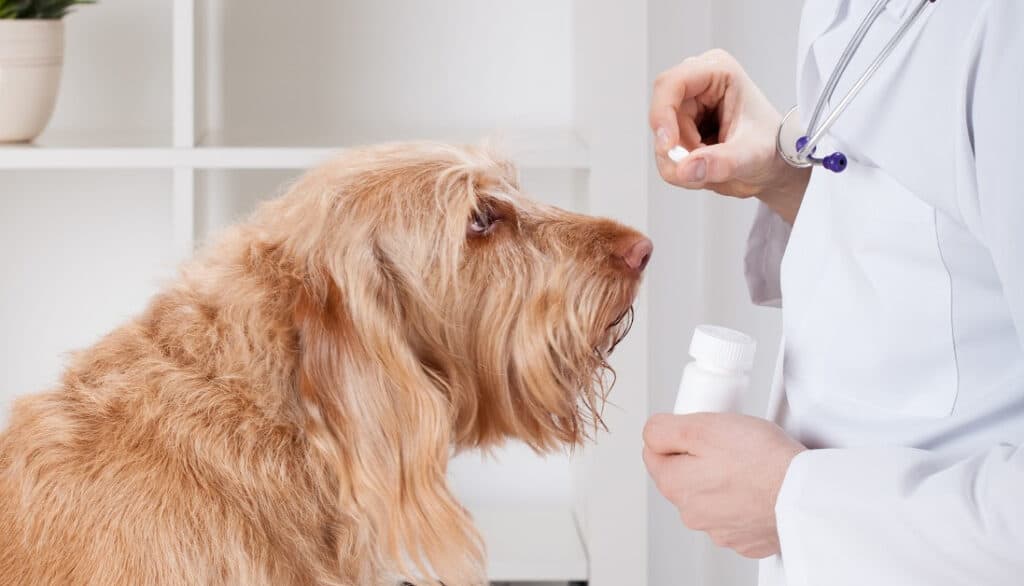
Omeprazole for Humans vs. Dogs: Is There a Difference?
Have you ever stood in front of your medicine cabinet, eyed a pill bottle, and thought, “Could this work for my pup?” Especially when you see certain medications, like Omeprazole, in both human and veterinary contexts. Let’s demystify this together.
At its core, the active ingredient in Omeprazole stays the same whether packaged for humans or dogs. Both designs aim to reduce stomach acid production and treat conditions like acid reflux or ulcers.So, in essence, the basic drug is the same.
However – and this is a big however – there are nuances to consider. The formulation or the additional inactive ingredients in human medications might differ from those in veterinary versions. These seemingly minor differences can be significant for our pets. For instance, certain additives harmless to us might be intolerable or even harmful for dogs.
Moreover, the concentration or dosage available in human Omeprazole might not align with what’s appropriate for our four-legged friends. This is where things can get tricky and why a simple “pill-splitting” method isn’t always advisable.
The takeaway? While the core of Omeprazole remains consistent across the board, the devil is in the details. Before raiding our medicine cabinets with the noble intention of helping our pets, it’s crucial to consult with a veterinarian. They’ll provide insights on safe usage and ensure our good intentions don’t inadvertently lead to unwanted complications.
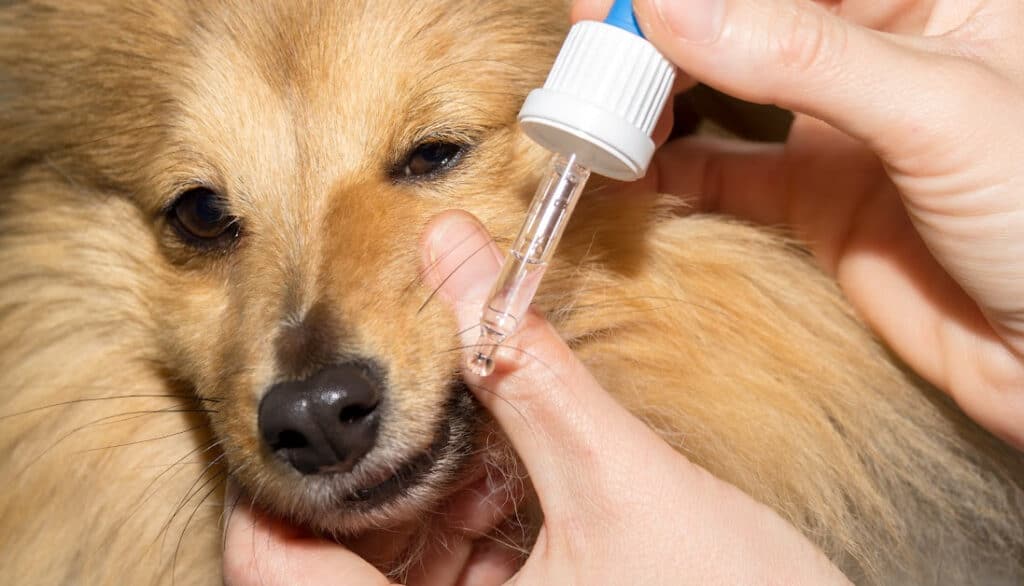
Uses of Omeprazole in Dogs
Ah, the versatile world of Omeprazole! Just as this little pill carves a niche in human medicine, it finds various uses in the realm of canine care. Let’s uncover some of the most common scenarios where our furry friends might benefit from this medication.
Gastric Ulcers
- What are they? Simply put, gastric ulcers form as sores on a dog’s stomach lining. They can be a real bother, causing discomfort and pain for our pets.
- How does Omeprazole help? Omeprazole acts as a stomach shield. By reducing the amount of acid the stomach produces, it allows ulcers the chance to heal and prevents them from worsening. It’s like giving the stomach a little breather.
Acid Reflux (GERD)
- What is it? Similar to the heartburn humans often complain about after a spicy meal, dogs can experience acid reflux, too. This is when stomach acid irritates the esophagus, leading to symptoms like coughing, gagging, or even vomiting.
- How does Omeprazole help? By acting as an acid suppressant, Omeprazole ensures that there’s less acid available to reflux into the esophagus. Think of it as turning down the volume on acid production, making meal times and post-meal lounging more comfortable for our pups.
Preventative Measures
- Why consider it? Vets sometimes prescribe medications or administer treatments to dogs that might raise the risk of stomach issues. In these cases, they might introduce Omeprazole as a precaution.
- How does Omeprazole help? By keeping acid levels in check, Omeprazole can act as a protective layer, ensuring that other necessary treatments don’t come at the cost of stomach health.
Delving into the world of dog health can sometimes feel like decoding a complex puzzle.
But as we understand each piece like Omeprazole, we equip ourselves better to ensure our furry companions lead comfortable, happy lives. Remember, always work closely with your vet to determine the best course of action for your pet’s unique needs.
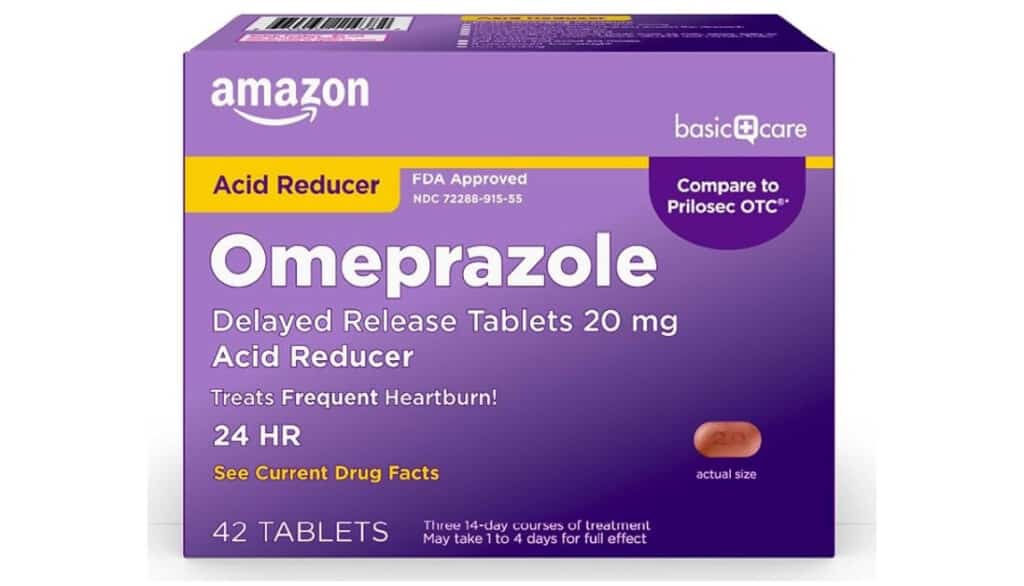
Side Effects of Omeprazole in Dogs
Navigating the realm of medications is a bit like setting sail on open waters. The destination is clear (better health!), but unexpected waves can arise along the journey. In the case of Omeprazole, while it offers many benefits, it’s essential to be aware of potential side effects that might surface. Let’s examine these closely so you can steer the ship with confidence.
Common Side Effects of Omeprazole
While not every dog will experience these, it’s good to have them on your radar:
- Digestive Upset: This might manifest as diarrhea, vomiting, or even flatulence.
- Loss of Appetite: You might notice Fido is less enthusiastic about mealtime. It’s a temporary reaction some dogs have while adjusting to the medication.
- Lethargy: Just as we might feel a bit off after starting a new medication, dogs can too. They might seem a bit more tired or less playful initially.
Less Common, but Serious Side Effects of Omeprazole
These are rarer, but it’s crucial to be aware and consult your vet if you spot them:
- Blood in Stools or Vomit: This is a sign that something isn’t sitting right, literally. It’s essential to address this promptly.
- Severe Diarrhea: An occasional upset tummy is one thing, but persistent diarrhea needs attention.
- Neurological Issues: If your pup seems unusually dizzy, uncoordinated, or has tremors, it’s a clear sign to get in touch with your veterinarian.
While the list might seem a tad daunting, remember that many dogs take Omeprazole without any hitches. The goal isn’t to alarm but to arm you with knowledge. Every dog is unique, and what works seamlessly for one might require adjustments for another. Always maintain open communication with your vet and monitor your dog’s behavior and health closely when introducing any new medication. Being proactive ensures smooth sailing, even on the medicinal seas!

How to Give Omeprazole to Your Dog
Let’s face it – administering medicine to our canine companions can sometimes feel like a mission.
When dogs wriggle, suddenly avoid treats, or spit out a pill you thought they swallowed, you need a mix of patience and technique to handle the task. Here’s a step-by-step guide on how to make the Omeprazole-giving process smoother for both you and your fur-baby.
Step-by-step Administration of Omeprazole
- Preparation: Ensure you have the correct dosage ready. Always double-check the pill or liquid measurement before administering.
- Use Pill Pockets: If you’re using pill form, consider pill pockets – these tasty treats can be a game-changer. Hide the pill inside, and most dogs will gobble it up, none the wiser.
- Liquid Form: If your vet has prescribed a liquid form of Omeprazole, use a syringe or dropper. Ensure your dog is calm, gently open their mouth, and administer the liquid to the side of the cheek, not directly down the throat to prevent choking.
- Follow with a Treat: Positive reinforcement works wonders. After successfully administering the medicine, give your dog their favorite treat. This not only rewards them but also ensures that the pill goes down smoothly.
- Monitor After Administration: Keep an eye on your dog for a few minutes after giving the medicine. This ensures they don’t spit it out and helps in spotting any immediate adverse reactions.
Omeprazole Dosing Chart For Dogs
Please note that the following is a general guideline. Always use the specific dosage recommended by your vet:
| Dog Size | Omeprazole Dosage |
|---|---|
| Small Dogs (10lbs or less) | 2.5 mg to 5 mg once daily |
| Medium Dogs (10 to 20lbs) | 5 mg to 10 mg once daily |
| Large Dogs (20 to 40lbs) | 10 mg to 20 mg once daily |
| Extra Large Dogs (over 40lbs) | 20 mg to 40 mg once daily |
Remember, giving medication is a mix of art and science. While you aim for precision in dosage, the method might need some creative adjustments based on your dog’s temperament and preferences. Always prioritize safety, create a calm environment, and of course, give cuddles after completing the task to make the process smoother for next time!
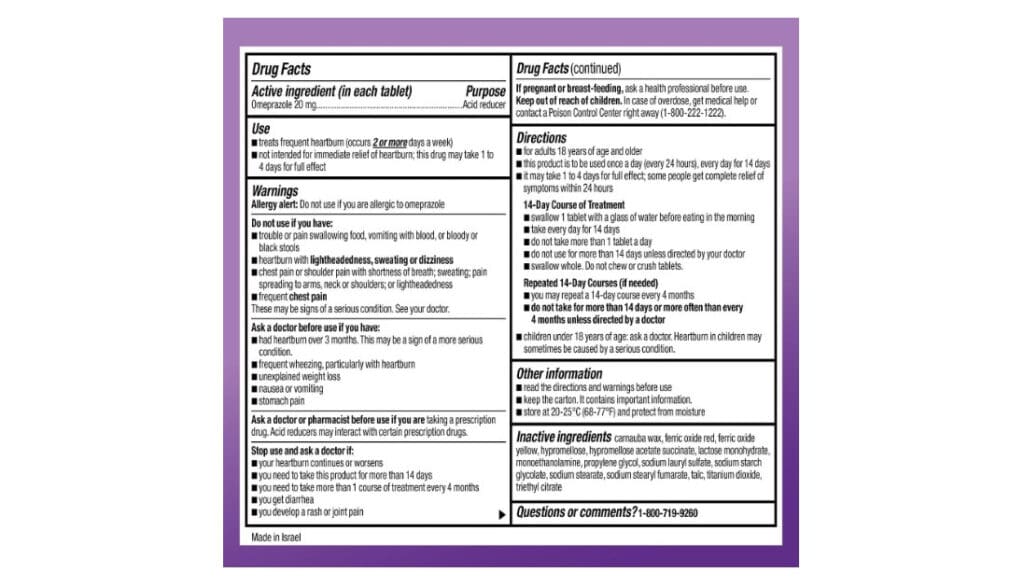
Omeprazole Alternatives & Dr. Candy’s Recommendations
It’s worth exploring alternative routes, especially when we have expert guidance to light the way. Dr. Candy, with her vast experience and dedication to animal health, has some noteworthy recommendations to consider:
Famotidine
- What is it? People often recognize Famotidine by its commercial name, Pepcid, as another acid-reducing medication.
- Why I recommend it: For some dogs, Famotidine might be gentler on the system, offering similar benefits without some of the side effects associated with Omeprazole.
- Usage Tips: As with any medication, it’s essential to consult with a vet regarding dosage and suitability for your specific pet.
Prilosec
- What is it? A bit confusing, right? While Omeprazole and Prilosec might seem interchangeable, Prilosec is actually a brand name for Omeprazole.
- Why I recommend it: The brand-specific formulation might sometimes offer a more consistent therapeutic effect due to its proprietary makeup.
- Usage Tips: Always follow prescribed doses and watch for any reactions, especially when switching from generic Omeprazole to Prilosec.
Slippery Elm
- What is it? Venturing into the realm of natural remedies, people have used the herb slippery elm for centuries to treat various ailments.
- Why I recommend it: For dogs that have minor digestive issues or for those who prefer a more holistic approach, slippery elm can soothe the digestive tract and reduce inflammation.
- Usage Tips: Since it’s a natural remedy, it’s crucial to source high-quality products. And, as always, discuss with your vet before introducing it to your dog’s regimen.
Health isn’t a one-size-fits-all approach. Every dog is a unique individual, and what works wonders for one might require tweaking for another. By staying informed, consulting experts, and always prioritizing our pet’s wellbeing, we can confidently navigate the multiple avenues of animal healthcare.
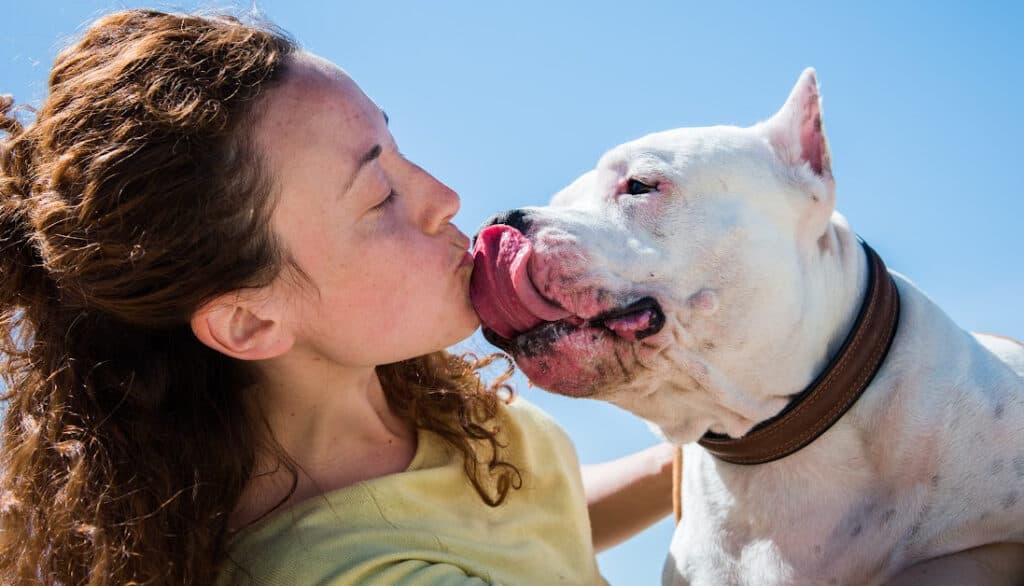
Conclusion
Journeying through the world of canine health can often feel like a maze, with its twists, turns, and overwhelming options. But with the right information, a keen eye, and a loving heart, we can chart a course that leads to the well-being of our four-legged family members. Omeprazole, like many other tools in our pet care arsenal, holds the promise of relief and comfort for our dogs when used wisely. However, as with all health decisions, a close partnership with your veterinarian ensures that the choices we make are in the best interests of our furry companions.
Navigating pet health isn’t just about medications or treatments; it’s a testament to the lengths we’ll go to ensure our pets lead the healthiest, happiest lives. Whether you’re exploring Omeprazole or seeking alternative routes, the compass that guides you should always be love, care, and informed choices. Here’s to many more tail-wagging, happy moments with your loyal companion!
Frequently Asked Questions
Omeprazole is a medication that is used to prevent and/or treat stomach ulcers. The FDA (U.S. Food & Drug Administration) has approved this drug for use in horses and humans. The FDA allows veterinarians to prescribe and use products containing this drug in other animal species in certain situations. You and your veterinarian can discuss why this drug is the most appropriate choice.
Many things might affect how well this drug will work in your animal. Be sure to discuss the following with your veterinarian so together you can make the best treatment decisions.
– Other drugs can interact with omeprazole, so tell your veterinarian and pharmacist what medications (including vitamins, supplements, and herbal therapies) you are giving your animal, including the amount and schedule of each.
– Tell your veterinarian about any conditions or diseases your animal may have or had in the past.
– If your animal has been treated for the same disease or condition in the past, tell your veterinarian about the treatment and how well it did or didn’t work.
– If your animal is pregnant, may become pregnant or is nursing, talk to your veterinarian about the risks of using this drug.
– Omeprazole can possibly reduce the birth weight of animals born to a mother receiving this drug.
– Tell your veterinarian and pharmacist about any medication side effects (including allergic reactions, lack of appetite, diarrhea, itching, hair loss) your animal has developed in the past.
This medication should help your animal feel better within 1 to 2 days. Your animal’s clinical signs should improve after that time. The effects of this medication are short-lived, meaning they will stop working within 24 hours, although the benefits may be prolonged if your animal has decreased kidney and/or liver function.
No drug is 100% safe in all patients, but your veterinarian will discuss with you any specific concerns about using this drug in your animal.
This drug SHOULD NOT be used in patients:
– That have had an allergic reaction to it or similar drugs in the past.
This drug should be used WITH CAUTION in patients:
– With liver or kidney disease.
– That are pregnant or nursing.
If your animal has any of these conditions, talk to your veterinarian about the potential risks versus benefits.
– Omeprazole is generally tolerated well by dogs, cats, and horses, but it could cause vomiting (not horses), decreased appetite (eating less), excessive gas, and diarrhea.
– There is one report of a horse showing signs of skin itchiness after getting the drug.
– You don’t have to be overly concerned if you see any of these signs unless they are severe, worsen, or continue to be a problem.
– Contact your veterinarian if this happens.
Usually, overdoses of omeprazole are not serious, but if you know or think your animal got too much of this medication and they are showing adverse effects, contact your veterinarian or an animal poison control center for further advice. Animal poison control centers that are open 24 hours a day include: Pet Poison HELPLINE (855-764-7661) and ASPCA Animal Poison Control Center (888-
426-4435); a consultation fee is charged for these services.
– For this medication to work, give it exactly as your veterinarian has prescribed. Do not cut or break tablets unless instructed to by your veterinarian or pharmacist. It’s a good idea to always check the prescription label to be sure you are giving the drug correctly.
– Omeprazole should be given about 30 minutes before a meal, generally the first meal of the day. If your animal vomits or acts sick after getting it on an empty stomach, give it with the meal instead. If vomiting continues, contact your veterinarian.
– The paste for horses should be given as directed by the veterinarian. The person giving the paste should pay attention to the marks on the handle of the tube. If you are not giving a whole tube of paste each dose, your veterinarian will show you exactly where to dial the ring on the tube to avoid overdosing your horse.
– Omeprazole is usually not used for longer than 4 weeks in dogs and cats or 90 days in horses. If the benefits outweigh the risks, however, it may be given for longer.
– Compounded liquid forms of this medication must be measured carefully. Your veterinarian or pharmacist can help by providing special measuring spoons or syringes.
– If you have difficulty getting your animal to take the medicine, contact your veterinarian or pharmacist for tips to help dosing and reducing the stress of medication time.
– This medication can be given for various lengths of time. Be sure you understand how long the veterinarian wants you to continue giving this medication. Prescription refills may be necessary before the therapy will be complete. Before stopping this medication, talk to your veterinarian, as there may be important reasons to continue its use.
If you miss a dose, wait and give the next dose when it is usually time to do so. Do not double-up doses or give an extra dose.
Store this medication in the original prescription bottle or an approved dosage reminder container (ie, pill minder) at room temperature, out of direct sunlight. Keep away from children and other animals. Liquids should be stored exactly as recommended and discarded by the date shown on the prescription bottle.
There are no specific precautions required when handling this medication unless you are allergic to it. Wash your hands after handling any medication.
– Do not flush this medication down the toilet or wash it down the sink. If a community drug “take-back” program is available, use this option. If there is no take-back program, mix the drug with coffee grounds or cat litter (to make it undesirable to children and animals and unrecognizable to people who might go through your trash), place the mixture in a sealable plastic bag to keep it from
leaking out, and throw the bag out with the regular trash.
– Do not save leftover medication for future use or give it to others to use.
– Omeprazole is available OTC (over-the-counter, without a prescription). Do not give omeprazole (or any other OTC medications) to your animal without first consulting a veterinarian.
– Do not change or switch dosage forms without first consulting with a veterinarian or pharmacist, as the dose may not be the same.
– Use of this drug may not be allowed in certain animal competitions. Check rules and regulations before entering your animal in a competition while this medication is being administered.
